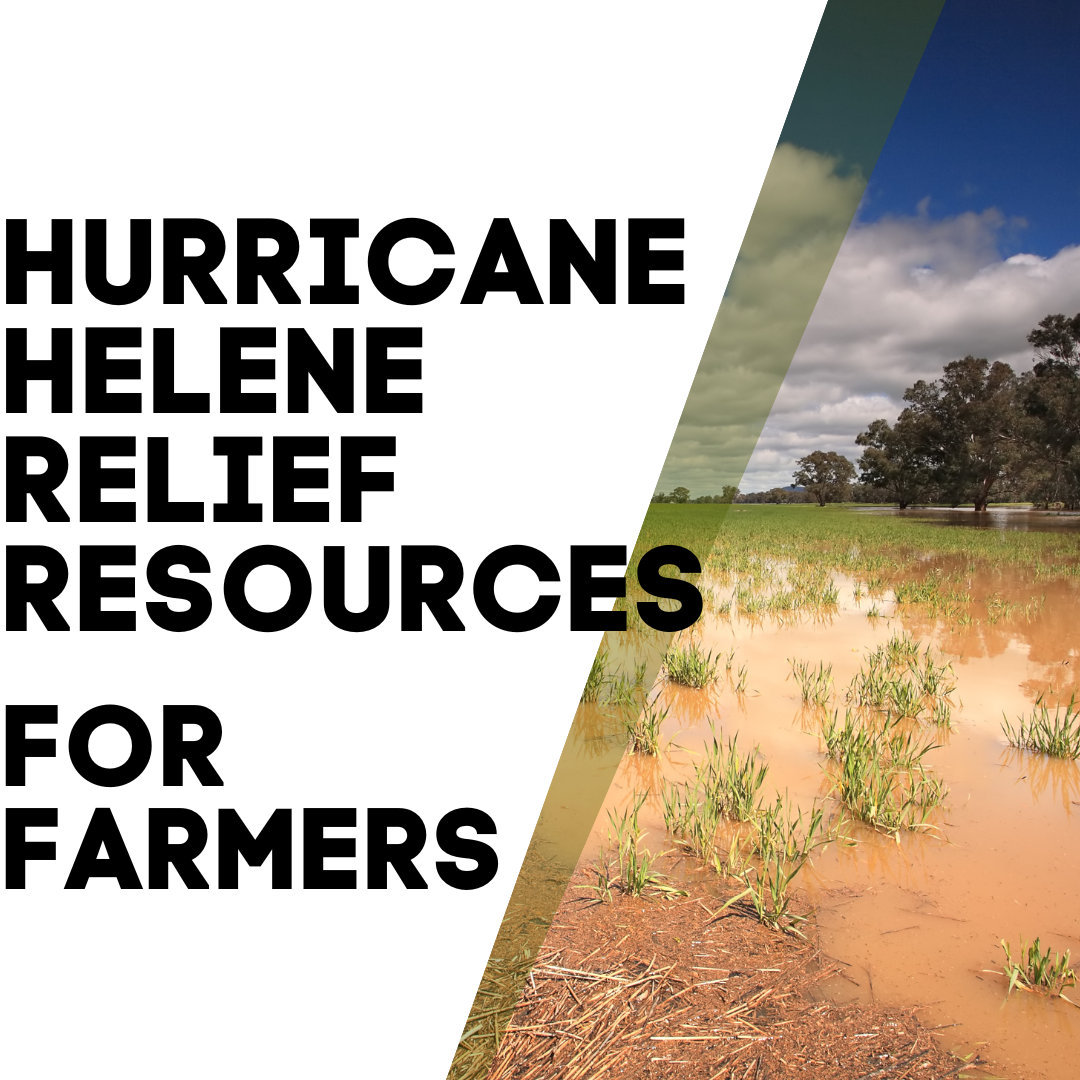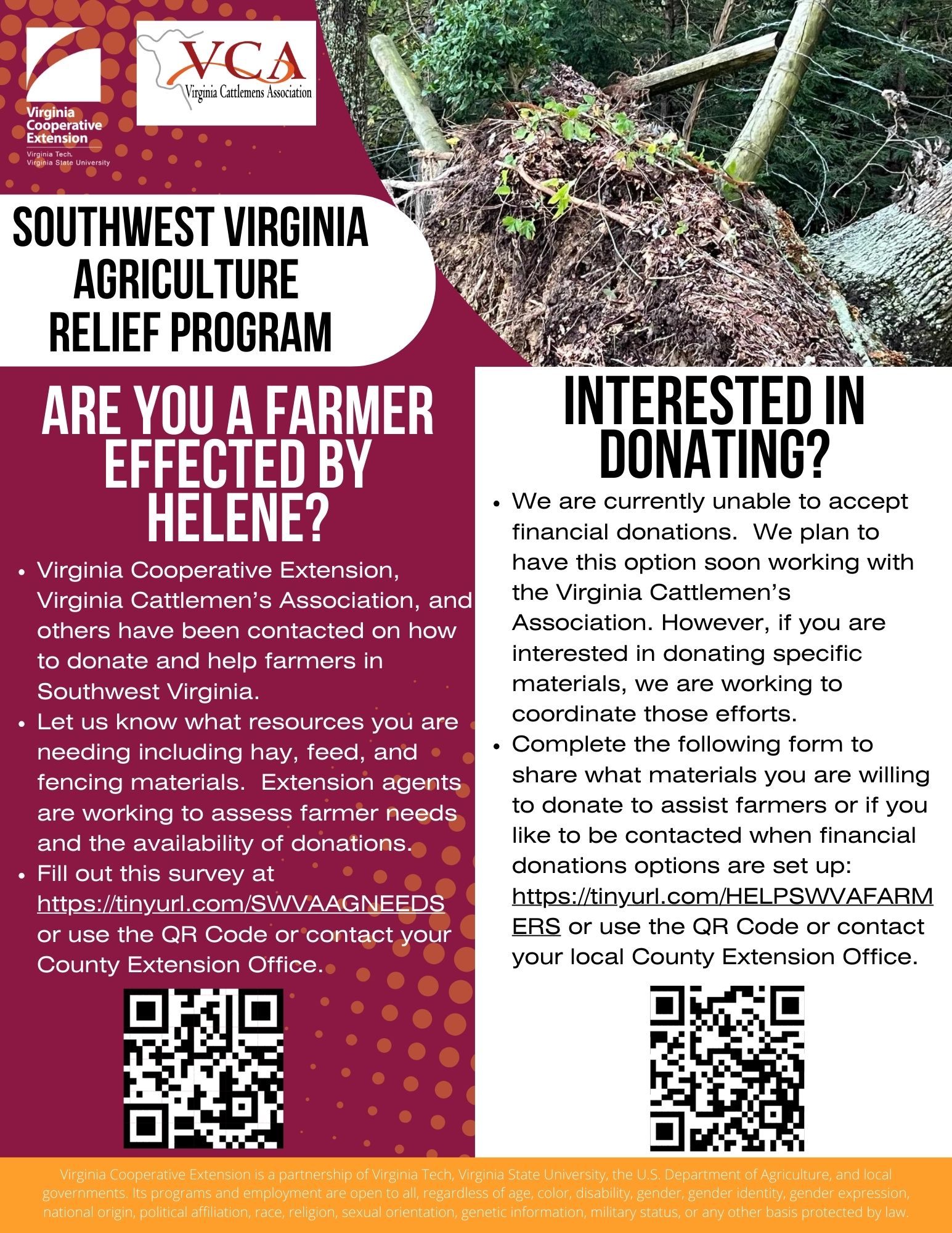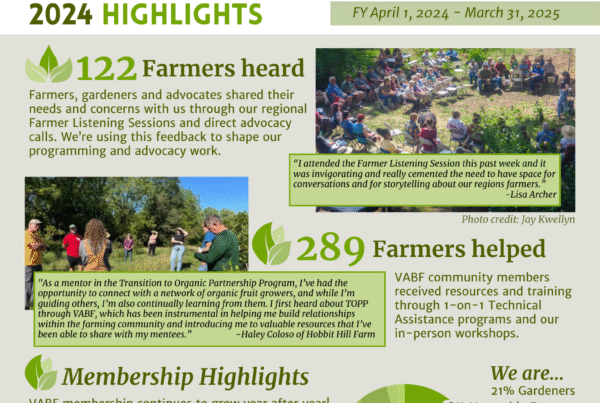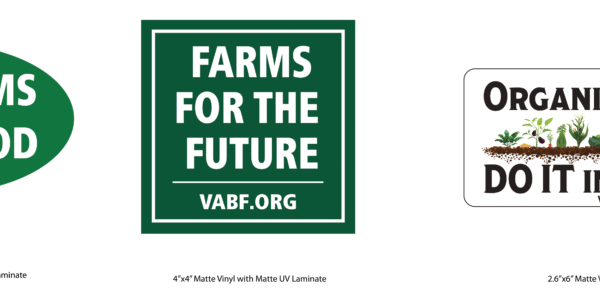Hurricane Helene had devastating impacts in parts of NC, VA, SC and TN. Our hearts go out to the Appalachian communities deeply impacted by Hurricane Helene.
Resources for Farmers below are from Virginia Cooperative Extension, NRCS Virginia, Virginia Emergency Management, RAFI, Farm Aid and USDA.
In addition the following organizations have extensive lists of resources on shelters, food and supply drop off and pick up locations, local volunteer and community groups, donation info, and telecommunication info. CFSA’s For Farmers list also includes a clearinghouse of farmer funding needs from severely impacted farms in the Asheville area through Organic Growers School and direct donations.
Running Resources for Helene Response & Relief – Carolina Farm Stewardship Association
Hurricane Helene Relief for Southern and Central Appalachia – Appalachian Voices
Virginia Cooperative Extension
Many counties in Southwest Virginia have received significant damages because of Helene. Many have reached out asking how they can help and are wanting to specifically assist farmers in need. Extension Agents in Southwest Virginia are working to assess farmer needs and the availability of donations. All those interested in donating can fill out this form:  https://tinyurl.com/HELPSWVAFARMERS.
We are working with farmers to assess their needs. Any farmer affected by the storm that needs assistance can fill out this form to let us know: https://tinyurl.com/SWVAAGNEEDS.  Extension Agents will also be adding farmers to the list with their needs.
NRCS Virginia
The Emergency Watershed Protection (EWP) Program offers technical and financial assistance to help local communities relieve imminent threats to life and property caused by floods, fires, windstorms, and other natural disasters that impair a watershed.  Emergency Watershed Protection Program.
Virginia Emergency Management:
Hurricane Helene Recovery  https://www.vaemergency.gov/recover/hurricane-helene
Southwest Virginia farmers pick up the pieces after Helene  – Cardinal News article from 10/1 documenting farm damage from farmers in SW VA.
Farm Aid
- Farm Aid Online Assistance Request Form and the Farm Aid Hotline at 1-800-FARM AID (800-327-6243) as well as the Farmer Resource Network, which is an online database of farmer support resources of all types. Plus, they have a Disaster Resource Guide with step-by-step advice, supported by links to relevant agencies. Farm Aid also provides emotional support for farm families 1-800-FARM AID (800-327-6243)
-
Emergency Grants
$500 Emergency Grants are given with the assistance of our Hotline team members, who answer calls on 1-800-FARM-AID, connecting farmers to appropriate resources and recommending emergency grants when support is urgently needed.
RAFI:
Steps Farmers should Take:
1. Document damage with dated photographs, videos, and third-party verification (non-family if possible).
2. It is critical to make every effort to report farm damage to your local USDA Service Center to request assistance (If the office doesn’t answer, be sure to leave a voicemail. You can find your local FSA number/alternative county number here.)
-
Call your local USDA service center to seek pre-authorization to maximize your chances of getting cost-share reimbursements for repairs.
-
If no one answers, leave a voicemail describing the damage and the repairs needed. Leave your name and description of the damage — include both emergency and long-term and a list of repairs for which you will request funding.
-
If the line is down, you may call any county office in your state.
-
3. Farmers should start taking notes in addition to pictures.
- What damage you’ve experienced
- What repairs you need to do
- What costs you incur in implementing repairs. Keep all receipts.
- Track and document your time and machine time spent on clean-up.
4. If possible to wait, do not start permanent repairs and field restoration without FSA authorization. You may do emergency repairs, e.g., gates, fencing, etc.
5. Links and Phone Numbers
-
Farmers may contact RAFI’s Crisis Hotline if you have questions or need assistance: 866.586.6746
USDA
Hurricane Helene Recovery Assistance
In the wake of Hurricane Helene, USDA staff is available to assist when you are ready. USDA is working diligently to implement program flexibilities and waivers, to help streamline your recovery process. We are regularly reviewing our programs so please check in periodically with your local USDA office for updates.
Documenting LossÂ
We encourage you to document damages and losses your operation has sustained as best you can, including gathering farm records, herd inventory, receipts and pictures of damages or losses. Livestock producers are advised to document livestock numbers by taking time and date-stamped video or pictures of injury or loss, to the extent possible. Please know that we recognize these are extremely extenuating and stressful circumstances and there may be instances where documentation is lost, destroyed or unattainable. Regardless, please contact us and we will do whatever we can to help you access the assistance you need.
Reporting LossÂ
Once you are able to safely evaluate the impact on your operation, be sure to contact your local USDA Farm Service Agency (FSA) county office or your crop insurance agent to report all crop, livestock and farm infrastructure damages and losses. For producers who have risk protection through Federal Crop Insurance, the USDA Risk Management Agency has authorized Approved Insurance Providers to provide flexibility on reporting requirements for those who are unable to report losses due the disaster.
Available AssistanceÂ
Producers in counties with a primary or contiguous disaster designation may be eligible for low interest emergency loans to help them recover from production and physical losses.
Additionally, FSA offers several loan servicing options available for borrowers who are unable to make scheduled payments on their farm loan programs debt to the agency because of reasons beyond their control.
Meanwhile, the USDA Natural Resources Conservation Service provides financial resources through its Environmental Quality Incentives Program to help with immediate needs and long-term support to help recover from natural disasters and conserve water resources. Assistance may also be available for emergency animal mortality disposal from natural disasters and other causes.
Online Resources and ToolsÂ
To learn more about programs available to producers here are some resources on  farmers.gov, the Disaster Assistance Discovery Tool, Disaster-at-a-Glance fact sheet, and Farm Loan Assistance Tool can help you determine program or loan options.  Additionally, FarmRaise offers an FSA educational hub with livestock disaster assistance decision tools as well as farm loan resource videos.
Disaster Recovery Programs: Flexibilities and Waivers Â
USDA has issued program delivery flexibilities and waivers. We know this is a lot of information, but we want you to know what’s available as quickly as possible. As the recovery process progresses, there may be more flexibilities and waivers needed. Updated information will be timely shared as details unfold.
The information below describes some of the current program flexibilities and waivers, as of Oct. 3, 2024, available for producers impacted by Hurricane Helene. To learn about benefits available through our recovery programs including those listed below, please view the  Disaster-at-a-Glance fact sheet.Â
- Emergency Conservation Program (ECP) and Emergency Forest Restoration Program (EFRP):Â
- Extended ECP and EFRP signup that begins Oct. 15, 2024, and runs through June 1, 2025, in states affected by Hurricane Helene.
- Waiver of onsite inspection requirement for non-engineering practices for ECP and EFRP.
- Executed Emergency Response (ER-850) authorization of emergency National Environmental Policy Act (NEPA) circumstances to expedite FSA approval of practices involving surface debris removal, fence restoration, and non-ground disturbing activities.
- Livestock Indemnity Program (LIP):Â
- Guidance to FSA County Committees and local staff to exercise maximum flexibility in determining acceptable loss documentation and to ensure LIP applications are acted on timely.
- Emergency Assistance for Livestock, Honeybees, and Farm-Raised Fish (ELAP):Â Â
- Assistance to help cover above normal costs to transport livestock to feed and/or transport feed/forage to livestock in hurricane-impacted states.
- Assistance to help cover above normal costs to haul water to livestock in hurricane-impacted states.
- Tree Assistance Program (TAP):Â Â
- Extension of TAP assistance to trees/bushes/vines that have not died but are no longer capable of production (not economically viable).
- Non-Insured Crop Disaster Assistance Program (NAP):Â
- Waiver of 72-hour notification requirement on hand harvested crops.
- Extended deadline to file a Notice of Loss with FSA.
- Flexibility for FSA staff to perform loss adjustment activities and/or waive field inspections in cases where the cause of loss can be verified through other means.
- Marketing Assistance Loans (MAL):Â Â
- Additional time for producers to deliver commodities to a buyer to repay MALs with sale proceeds.
- Postponement of MAL foreclosure letters applicable to losses or damages due to hurricanes for up to 90 calendar days.








